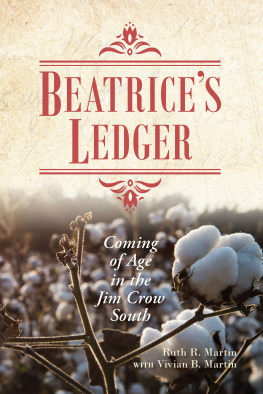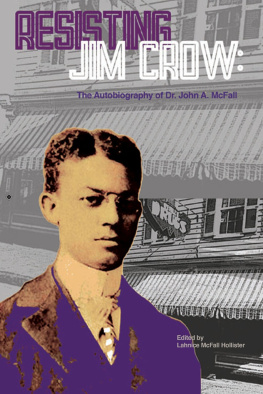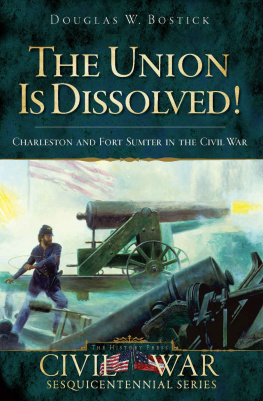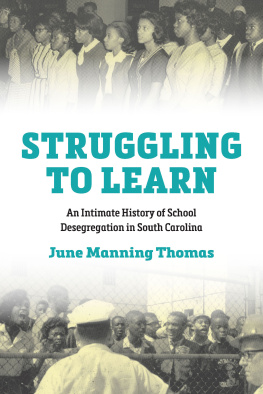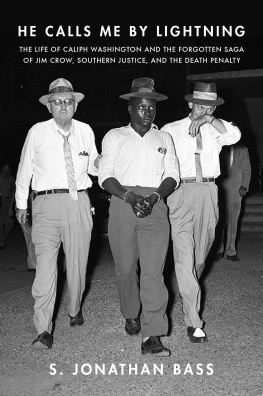

Published by The History Press
Charleston, SC 29403
www.historypress.net
Copyright 2008 by Daniel J. Crooks Jr. and Douglas W. Bostick
All rights reserved
First published 2008
e-book edition 2012
ISBN 978.1.61423.482.1
Library of Congress Cataloging-in-Publication Data
Crooks Jr., Daniel J.
Charlestons trial : Jim Crow justice / J. Crooks, Jr. and Douglas W. Bostick.
p. cm.
print ISBN 978-1-59629-576-6
1. Duncan, Daniel, d. 1911--Trials, litigation, etc. 2. Trials (Murder)--South Carolina--Charleston. I. Bostick, Douglas W. II. Title.
KF224.D86C76 2008
345.75791502523--dc22
2008030663
Notice: The information in this book is true and complete to the best of our knowledge. It is offered without guarantee on the part of the author or The History Press. The author and The History Press disclaim all liability in connection with the use of this book.
All rights reserved. No part of this book may be reproduced or transmitted in any form whatsoever without prior written permission from the publisher except in the case of brief quotations embodied in critical articles and reviews.
Dedication
This book is dedicated to the two people who first encouraged and inspired us to tell this story.
The late Professor Emmett Robinson of the College of Charleston researched the history of the Old Charleston County Jail and the local traditions concerning capital punishment. He personally encouraged us to tell the story of the murder of Max Lubelsky.
The late Melvin Simmons was chief deputy of the Charleston County Sheriffs Office. On a rainy day in the fall of 1988, he talked about the legend of the Duncan Storm as it had been taught to him by his grandmother.
Both of these men spoke of an injustice, of a wrong that needed to be made right. To that end, we have dedicated our efforts.
CONTENTS
ACKNOWLEDGEMENTS
This true story from the turn of the last century had been lost in history. We are indebted to many people who assisted in its recovery.
The staff of the South Carolina Historical Society placed all of its resources at our disposal and graciously responded to a multitude of inquiries. As always, we are indebted to the Charleston Library Society and its fine staff, who helped to unlock the treasures hidden in that collection. Additionally, the South Carolina Room of the Charleston County Library remains an indispensable part of any research focused on Charleston, South Carolina.
Harlan Greene, with the Avery Institute, reviewed early manuscripts and provided us with his expert observations and suggestions. Alphonso Brown contributed to our knowledge and understanding of Lowcountry Gullah history.
Several members of the Charleston Police Department provided technical assistance to the authors concerning evidence and crime sceneprocessing techniques, as well as homicide investigation. The efforts of Detective Captain Gary Tillman, Detective Sergeant Barry Goldstein and Forensic Science Director Judy Gordon are greatly appreciated.
Charleston police officer Timothy Reed shared with us his collection of Charleston police memorabilia, which allowed us to add to the historical realism of our story.
The Wilton Poulnot Jr. family kindly provided us with family pictures and the opportunity to examine Sheriff Poulnots first badge of office, given to him by Sheriff Martin in 1904. Our longtime friend Edwin Poulnot III gave early direction to the project and also provided us with useful historical insights about Charlestons past.
Argentini Anderson, former assistant administrator with the Ninth Circuit Solicitors Office, researched and identified early court records and documents. The office staff of Emmanuel AME Church, with the assistance of Reverend LaVerne Witherspoon, provided the authors with photographs from church and congregational archives.
A special thanks to Norman Lubelsky, Joseph Lubelsky Jr., Dolly Lubelsky Young and Kate Georgia Lubelsky. The surviving grandchildren of Max and Rose Lubelsky met early on with the authors, providing us with photographs and memoirs. Their recollections of Max and Rose allowed us to personalize their lives. We greatly value their kindness and friendship.
Prior to his retirement, Rabbi David Radinsky provided us with a concise and compelling history of the Orthodox Jewish community in Charleston.
We are indebted to the late Dorothy Moultrie for taking the time to sit with us in the reception area of her funeral home, sharing the stories told to her by her grandmother about Daniel Duncan and the Duncan Storm. As a quiet protest, she and her siblings were raised to never walk directly in front of the Lubelsky store.
Young Ward Nichols, only ten years old in this story, ultimately became the senior bishop of the African Methodist Episcopal Church. Prior to his death, he agreed to meet with us to share his firsthand account of the events that occurred on July 7, 1911. The detail and precision of his account demonstrated a memory that was still sharp and clear, despite his advanced age. His recollections added measurably to this story.
Finally, we would be remiss if we did not thank the two people who have stood with us, encouraging us and allowing us the freedom to pursue our passions. To our wives, Lynn Crooks and Karen Bostick, thank you for your patience and love.
CHAPTER 1
DAY OF DELIVERANCE
Friday, July 7, 1911
The morning sun began to rise, illuminating the port city of Charleston. From the east, the city seemed to ascend from the ocean, a North American Venice. As the first rays of light pushed across the harbor, the silhouettes of the many ships at anchor began to appear. The multitude of songbirds and sea gulls began to awaken and set out on their daily search for food.
The honey dippers had already made their rounds, empting the privy vaults through town; they had removed the waste from the vaults bucket by bucket, leaving a deposit of lime behind to stifle the stench. On their wagon, loaded with barrels filled from the privies, two black men eased down Queen Street, anxious to be finished for the night.
As the mule pulling the waste continued on its journey to the Phoenix Sanitation Company, it was clear that the two men were merely passengers aboard the pungent wagon. Sharing a libation after a long nights work, each man prayed they would reach their destination before the sun began to heat the day, rendering their cargo all the more intolerable.
Adgers Wharf was already a witness to the activity of the day as men started the arduous task of moving massive cotton bales aboard ship. Smokestacks were already burning, anticipating a morning launch to New York, delivering cotton to the Yankee factories.
The City Market was full of activity as butchers readied their fresh cuts of beef, chicken and lamb. The Charleston eagles, known elsewhere as buzzards, were waiting on the rooftops, hungry for the scraps that would soon be discarded in the streets.
The men of the mosquito fleet, a flotilla of small boats and dinghies operated by both island and city blacks, were offloading their early catch. Oysters, crabs and fish filled each boat, leaving scant room for the fishermen. Dozens of porgy, a prized sort of chub, filled the baskets. After sorting their daily stock, strong black men pushed overloaded carts filled with the delights of the sea through the city, chanting their familiar cry, Swimpee, swimpee, I gotcha swimpee!
Next page


